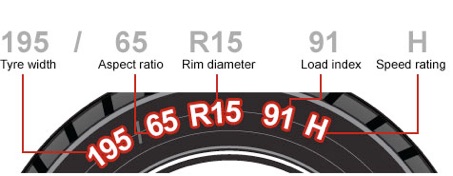Tyre Size
Your tyre size can be found on the sidewall of your current tyre and is a sequence of numbers and letters. The most common tyre size in the UK is 205/55R16 but there are many variations so it’s important to check your existing tyre or to check your vehicle handbook to ensure the right tyre size has been installed.
Tyre width
The first three digits. This displays the width of the tyre in millimeters. A tyre marked 225 will measure 225mm across the tread from sidewall to sidewall.
Aspect ratio
The fourth and fifth digits of the tyre code that immediately follow the tyre width. The aspect ratio or profile height of the tyre sidewall is expressed as a percentage of the tyre width. So an aspect ratio of 55 for example means that the profile height of the tyre is 55% of its width.
Radial
Radial tyres are marked with the letter R. Radial tyres are constructed with the cord plies positioned at a 90 degree angle to the direction of travel to give the tyre additional strength. Almost every new tyre manufactured today is a radial tyre.
Wheel diameter
The next two digits represent the size of the wheel rim that the tyre can be fitted to. It is also the diameter of the tyre from bead to bead. So a tyre marked 16 will fit on a 16-inch wheel rim.
Speed Rating
The speed rating of a tyre is represented by a letter of the alphabet at the end of the tyre size code and indicates the maximum speed capability of the tyre. Tyres receive a speed rating based on a series of tests which measure the tyres capability to handle a set speed for a prolonged period of time.
Load Index
The load index provides information on the maximum weight capability for the tyre. The load index is a numerical code that can be located just after the tyre size marking and before the speed rating.
Select your load index to find out the maximum load capability for your tyres.
Date of Manufacture
Your tyre is also printed with information about when and where the tyre was manufactured. This is represented by a series of letters and numbers which starts with the letters DOT (meaning the tyre exceeds Department of Transport safety standards).
The first 8 characters that follow DOT are essentially a serial number used by the manufacturer to identify the tyre and in which production facility it was made.
The last four digits, usually presented in a small window can help you to identify the age of the tyre.
The first two digits represent the week of the year the tyre was produced from 1 to 52. The last two digits represent the year. So a tyre marked 1315 was manufactured in the 13th week of 2015.
Tyres age over time, which can be accelerated if the vehicle is used infrequently. If the date of manufacture on your tyres is in excess of 6 years, we recommend having your tyres checked out to ensure they are still roadworthy.
















